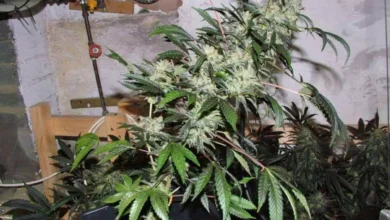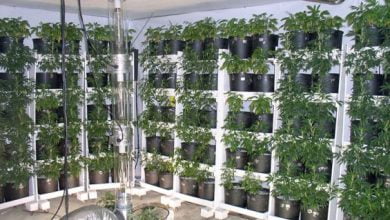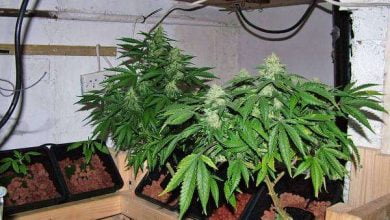Vertical Growing
2 growers, Simon from Montreal and Ian from Michigan, have totally opposing views on vertical expanding. Simon enjoys it, whereas Ian hates it. We thought it would be enjoyable to get them both on a teleconference and let them hammer it out. What follows is an abridged version of a two-hour-long heated dispute! Brace yourselves
“Noob” growers often scratch their heads when they initially find out about the idea of vertical growing . “Don’t plants grow upwards usually?” they ask. Let’s get the distinction in between horizontal (routine) growing and vertical growing sorted out straight away.
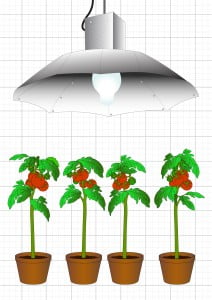 Horizontal growing
Horizontal growing
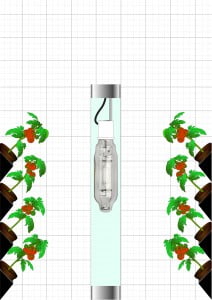 Vertical growing
Vertical growing
Horizontal growing is how most gardeners (outdoor and indoor) work. Plants are grown in pots or systems along a horizontal plane and the grow light/s are positioned above the plants, mounted in a reflector so that the light gets beamed down to where it’s required.
Vertical growing includes positioning the plants in a 360-degree formation around a grow lamp (occasionally in a cool tube but utilizing no reflector). The general idea is that you make the best use of using the height in your garden and make the most valuable light energy without the use of reflectors. Plants in vertical growing systems often be a lot smaller, implying shorter veg times but far higher plant numbers.
Everest: Okay men, thanks for joining us. Now I understand you’ve been blasting each other on the forums and you’re probably bursting at the seams to get choosing this one, but first, can you each talk a little about your growing experience so the people out there have an idea about where you’re both originating from?
Ian: Sure—I’ve been growing indoors for just over 10 years. I began with potting soils, experimented with the majority of hydroponic systems (NFT, ebb, flow and drip, aeroponics) and a huge selection of growing media, and now I grow with coir making use of pots in a homemade drip system. I’ve stood by while a few of my buddies tried, and mostly failed, with vertical growing systems as well as assisted a couple of managing them for a while, which is why I would never ever suggest one to an interested grower.
Simon: Well I’ve been growing on and off for around 15 years. I began with soil; I think 99 % of individuals do. Then my local grow store switched me on to coco. I’ve tried clay pebbles too, in some cases blended with rock wool croutons. I’ve run ebb and flow, NFT, drippers you call it. I’ve tried and failed with aeroponics. However, to be truthful, it was down to my ineptitude as opposed to anything else. But unlike Ian, I don’t dismiss a method out of hand just because it didn’t work for me. I’ve been running an ecosystem since they began the market. I’ve got my finest results ever before from vertical growing– it rocks!
Ian: Hang on, I’m not ‘dismissing’ vertical growing and, no disrespect, but personal bests are relative to the person. I’m just here to argue that vertical growing systems are not all they’re cracked up to be. I’m not even going to bring into the argument the phenomenal cost of vertical systems, which is enough to put a lot of people off. I want to focus on the practicality of using these systems, and why they suck.
Ian: Hang on, I’m not ‘dismissing’ vertical growing and, no disrespect, but individual bests are relative to the person. I’m just right here to argue that vertical growing systems are not all they’re split up to be. I’m not even going to bring into the argument the sensational expense of vertical systems, which suffices to put a lot of individuals off. I wish to focus on the functionality of using these systems, and why they suck.
Ian: You make it appear so simple! Ha ha. Ok, this I’ll offer you. Some vertical growing systems are really quick and easy to set up. Others however are a horribly difficult task! I’ve had the joy of filling a Coliseum– 300 plant websites with 3 x 1000 W lights– with a 265-gallon mix of vermiculite and perlite and, boy oh boy, it was a headache! It took the two of us the finest component of 4 hours, and I’m not speaking transferring, simply filling the system with growing media! Never ever again!
Vertical Growing
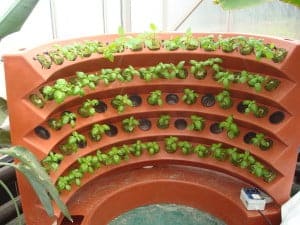 Vertical Plant Growing systems are wonderful for growing leafy natural herb crops in a small space as well as fruits and flowers. Note how this grower selected not to make use of all the planting sites.
Vertical Plant Growing systems are wonderful for growing leafy natural herb crops in a small space as well as fruits and flowers. Note how this grower selected not to make use of all the planting sites.
Simon: You’re discussing growing 300 plants. And duh, guess exactly what, that includes preparing 300 plant websites. Sorry if you’re working timid Ian however, obviously, it’s visiting take some labor to prepare! If I might find a system that filled itself with grow media, emptied itself, and replanted itself, I ‘d probably choose that, however …
Ian: Now you’re being both facetious and dumb Simon. However, a minimum of you’ve made a salient point against vertical growing on my behalf! Aren’t we really discussing making the most from your grow lights– in this instance, 3 x 1000 W. Don’t we have to ask why 3 x 1000 W grow lights should demand 300 plants in the first place !? It could just as quickly light 18 huge plants in five-gallon pots, topped three, 5 x 5 ft ebb and flow trays. It’s going to take me … exactly what … 10 mins to fill 18 pots, not four hours to fill 300 plant websites?
Simon: And how long to veg up those “18 large plants” you discussed?
Ian: Well, with 6 plants under a 1000 W … 10 days, perhaps 2 weeks?
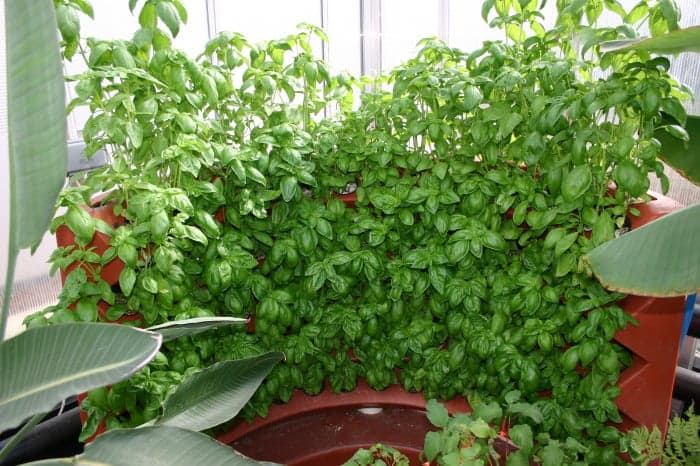 Basil gone nuts in a Coliseum! Routine cut and come again harvesting will keep this wall of basil in check!
Basil gone nuts in a Coliseum! Routine cut and come again harvesting will keep this wall of basil in check!
Simon: (Cackles) two weeks! That’s ridiculous! Compare it with my two-day veg time for micro-plants in a vertical grow. My crop cycles are almost half a month less than yours. You’re getting what … a maximum or five crops a year, whereas I’m constantly pushing six, making use of less energy too as I don’t have to have veg lights on for 18 hours a day for 2 weeks– ouch! I wouldn’t like to see your electricity expenses!
Ian: But what about your plant numbers dude? They have to be astronomical! In vertical systems, you need anywhere between 80– 300 identical cuttings for a two- or three-light system. In my four-light space I grow 24 plants, and to prepare for this I take 40 cuttings from one mother plant. Appears a little extreme to some however I only select the healthiest 24 with identical branch and node formation, the others I trash or give away. This selective strategy helps me accomplish an extremely consistent crop, level canopy, and constant yields.
Everest: what about Simon’s point on veg energy and times usage? Does not that concern you at all, Ian?
Ian: Well all of it seems so wonderful in theory does not it? Veg under metal halides for a few days and transplant into the system and bosh– straight into flower on a 12/12 light cycle. That’s what my buddy did and he discovered, due to the small veg time in the system, that some plants did not establish well enough and got left behind while others overgrew and overshadowed them.
Simon: I’ve had that problem too. I overcame it by making certain that roots were exploding out of the rock wool cubes before transplanting them into slabs. (Not simply one or two.) I ensure those slabs have actually been pH adjusted and I water my transplants individually with some CANNA Rhizotonic and a moderate, balanced bloom formulation at around EC 0.8 and pH 5.5– 5.8. I veg in the slabs horizontally for a couple of days, enabling the cuttings time to anchor in a little. Some plants will always exceed others– that’s natural. But I still wind up with a lovely canopy, regardless. The trick with vertical growing is to choose the right kind of phenotype that does not stretch and get all gangly. You should truly understand what you’re handling.
Ian: Yeah, yeah, but back to uniformity of cuttings for a moment; it’s much easier stated than done. And it’s so important to get right with vertical gardens, where plants are grown extremely close together and should be kept small and squat, so identically sized cuttings are even more essential. This means for a 300-plant system I would have to take a minimum of 400 cuttings (ideally 500), which implies requiring lots of substantial donor plants to take them from. For my four-light room, I have a two-tiered shelved propagation outdoor tents, which is 4 x 2 x 4 ft, with 2 short stocky mother plants and my cuttings. To take a set of 400 cuttings you’d require an additional two-light grow space! How is that conserving space, let alone energy? It’s just moving all of it elsewhere! The entire thing’s an inadequately marketed gimmick.
Simon: Yeah, you need lots of uniform cuttings to make vertical growing work, and not all plant species or varieties are ideal. Yeah, you should know exactly what you’re doing. I wouldn’t suggest this technique to a novice. But the reality stays, I’m pulling six crops a year, you’re pulling four or five. I produce the 140 cuttings I need for my Ecosystem from 2 bushy mom plants under 2 x 400 W metal halides. Maybe they aren’t constantly as consistent as I ‘d like though. More mother plants would assist. I root them in a number of conventional propagators under 2 banks of High Output T5 Fluorescents. And I veg them into rock wool slabs for two days under 250W metal halides.
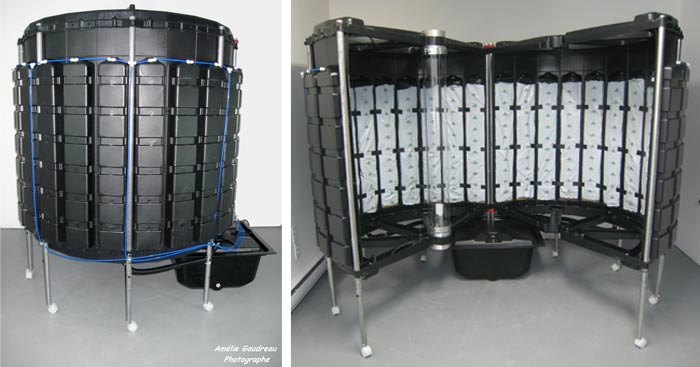 The Ecosystem 2
The Ecosystem 2
(which looks suspiciously like a design by Heath Robinson a vertical grower and designer) includes numerous enhancements over its predecessor including a separate tank, an increased number of plant sites, and more versatility with a selection of growing media.
Ian: But two days isn’t enough veg time. The plants can’t lay down good foundations for their flowering cycle in such a brief amount of time. Also, would not you agree that vertical cultivation it’s not about less work for the grower, it’s even more work with the propagation? Stressing over hundreds and hundreds of cuttings is not my concept of satisfying indoor gardening. I’d rather be chilling and admiring my plants in my flatbed garden.
Simon: Well I guess we’re going to agree to differ on that one. Chill all you want with your five crops a year. I’ll happily “stress” over my six crops a year, thanks!
Ian: Yeah, I know annual yields can be enhanced with short veg times, but six crops a year can be done with sea-of-green in horizontal gardens too, not simply in elegant vertical systems. I’ve played around with higher plant numbers making use of ebb and flow trays and can value the quick turn around, however as I’ve already said, the time and effort bought preparing the growing and propagating the plants to get these larger yields is unworthy the effort in my humble viewpoint.
Everest: Okay, let’s proceed to an additional crucial part of vertical systems: cool tubes. The majority of vertical systems use glass air-cooled tubes to remove the heat from the light so the plants can bask closely to the light.
Ian: Yeah, however certainly these tubes lower the amount and quality of light reaching the plants. I chatted to the man at my grow store about this and he reckons that curved glass reduces the light intensity by around 5 % in comparison to flat glass which is around 3 % compared with the open style reflector. I veg and finish my plants with metal halide lamps, making use of HPS in-between. Ever attempted to swap out the lamps on a vertically mounted cool tube when there are lots of plants in the system? Trust me, it’s not easy.
Simon: Sure, glass stops UV (which promotes the advancement of essential oils) and lessens light intensity a little, however, this is all even more than neutralized by the fact that you can get your lights closer to your plants. Also, many Ecosystem growers right here in Montreal do not utilize cool tubes at all; they merely drive lots of fresh air with the system. I’ve seen plants simply inches away from 1000 W lamps! With enough air movement, they’re okay.
Ian: You’ve got to ask yourself about the capacity for all those plants crowding out a cylindrical vertical system; there’s a distance in between the light and the canopy, which can not be adjusted on the majority of designs. This means as the plants grow from the system towards the light, the overall canopy size reduces as the crop grows! Consider it. Many vertical systems are circular; as the crop grows it gets closer to the light so the round crop canopy begins the exact same size as the system and gets smaller as the canopy strategies the light. Not to discuss the plants turn into a location of high light intensity, possibly too high, in addition to into a location of greater temperature level. The only means to get around this is to have the option of relocating the plants further far from the main light column, and a lot of vertical systems simply don’t have this functionality.
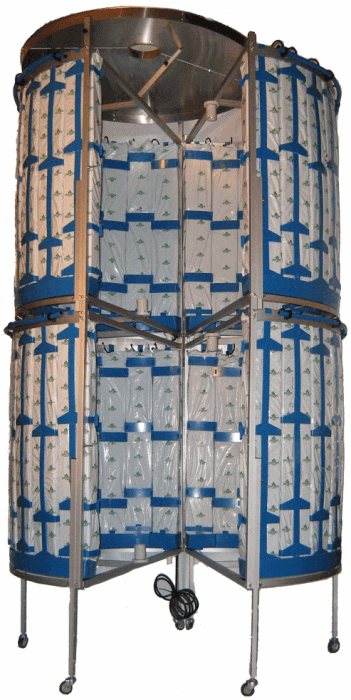 The Shark Cage also makes use of Rockwool slabs however can likewise be stacked.
The Shark Cage also makes use of Rockwool slabs however can likewise be stacked.
Simon: You need to get numerous elements right for a great vertical to grow: a plant variety that doesn’t go all leggy; the right number of those plants, and the right quantity of veg time. The majority of growers who ruin their vertical growth just over-veg their plants.
Ian: Yeah, however, all the planning in the world does not make up for a hot spell that triggers your plants to stretch. There’s just a lot less margin for mistakes in vertical systems. Whereas in my horizontal yard, I easily lift the lights when I should, with no reduction in canopy size.
Simon: But exactly what about efficiency? cultivating plants 360 degrees around a lamp means every photon has a direct course to a leaf, as opposed to counting on reflectors (which can reportedly move spectrums and collect heat).
Ian: This argument for vertical growing is the most convincing and typical– you get to make the most from the light emitted from the entire light, without using a reflector.
Vertical Grow Species Selection
You HAVE to utilize plants that grow stocky and short, and have incredibly tight internodes. Experience with growing the variety in horizontal gardens is a must. You need to understand the ins and outs of every facet of the plant before trying to grow it successfully in a vertical grow: Is it specifically susceptible to transplant shock? Does it produce quickly, anchoring roots? The amount of stretch does it put on when triggered to flower? Does it react well to frequent pruning into a single stem? Can it support its own weight without any plant supports? It is resistant to fungal diseases, particularly botrytis?Simon: Finally, you’ve had to say something positive about vertical growing.
Ian: Don’t get too ecstatic. I’m not done yet. With nearly all grow systems, the workload is more at the beginning and end of the cycle, but with vertical systems, the work can quickly result in an absence of motivation. The timing needs to be spot on to get the crop cycles right and it’s no easy job. The buddy I aided with the Coliseum took at least a week to reverse a gathered crop into a newly grown one, which obviously consumed into the salesman’s pledge of 6 crops a year.
Vertical Grow Environmental Control
Maintaining short, stocky plants in a vertical growing system is a must. Poor control over temperatures in your indoor garden can easily lead to high day-time (lights on) temps and comparatively low night-time temps; the exact opposite of what you want for good short stocky growth. Tight environmental control can help prevent overcrowding. Having a small or zero temperature difference (dif) between day and night will keep plants short.
Simon: Nobody stated getting bigger yields was easy Ian, unless you think the less meticulous nutrient producers simply wish to sell you 3 various bloom boosters and nineteen bottles of supplements.
Ian: That’s an entire ‘another story! The only genuine advantage of vertical gardening, as far as I see it, is saving on floor space. Comparable yields can be attained with horizontal gardens with the same amount of light, and a lot fewer plants. It is possibly real that once totally dialed in, the increased lighting efficiency can assist enhance yields, however definitely not by double as I have actually seen in some marketing literature for vertical grow systems. I would rather make use of extra light and a couple of extra plants in a horizontal garden, than go vertical.
More info on vertical growing


